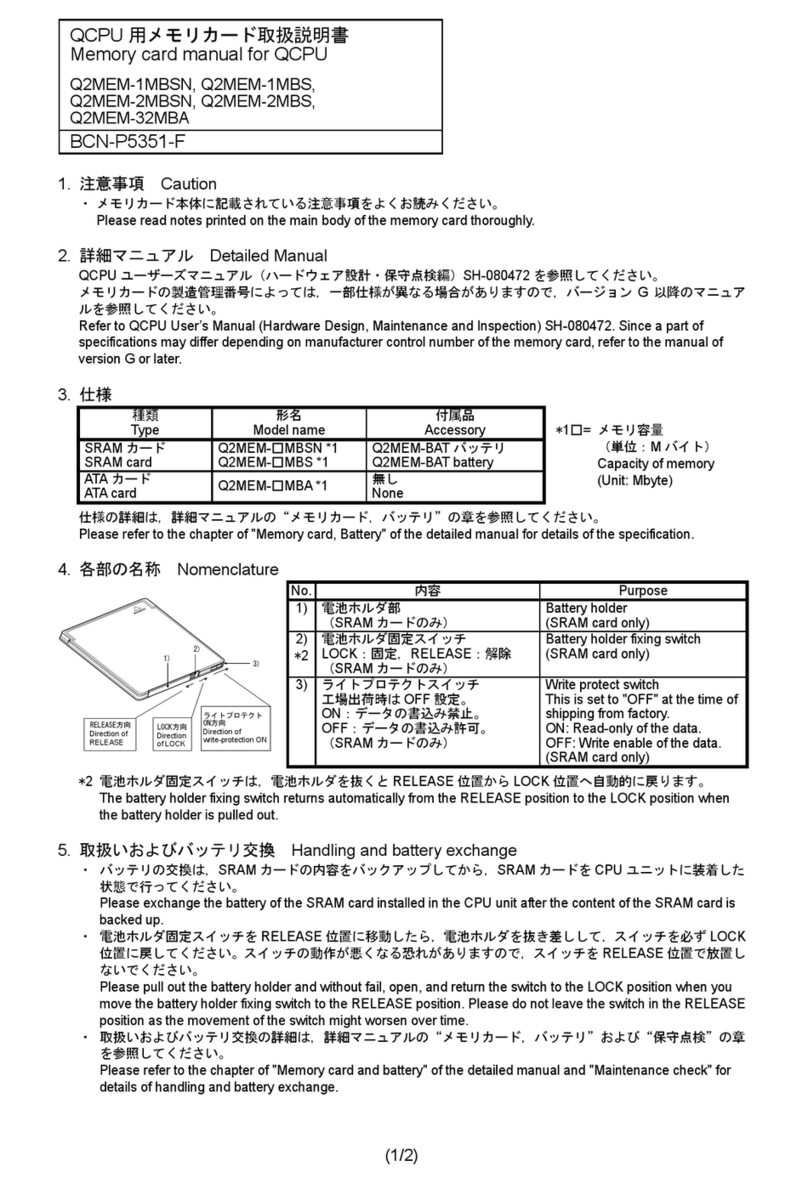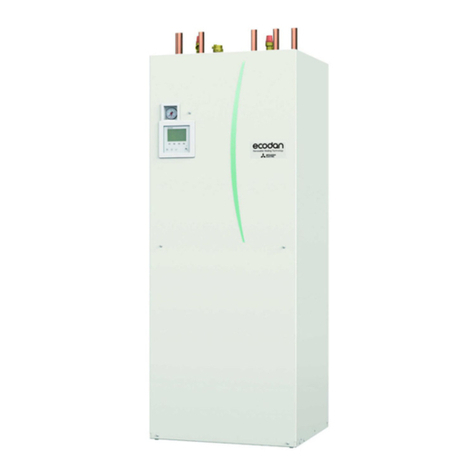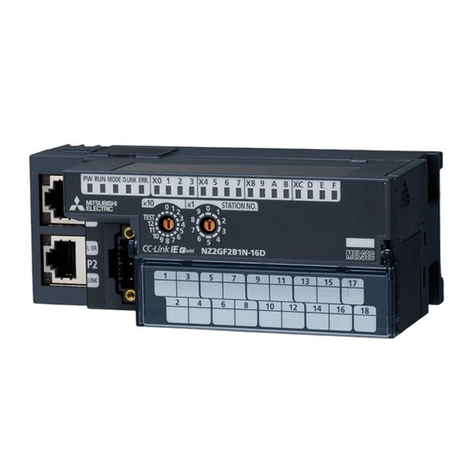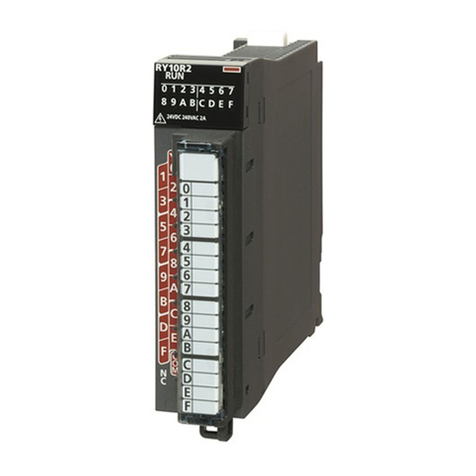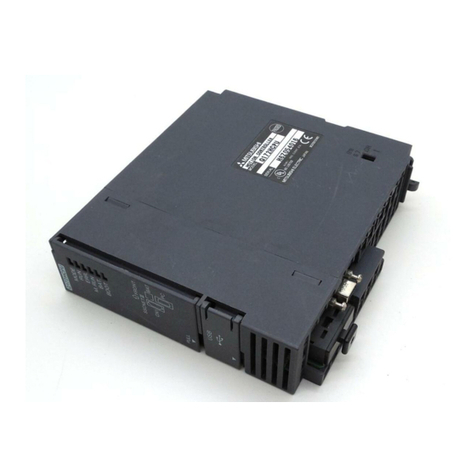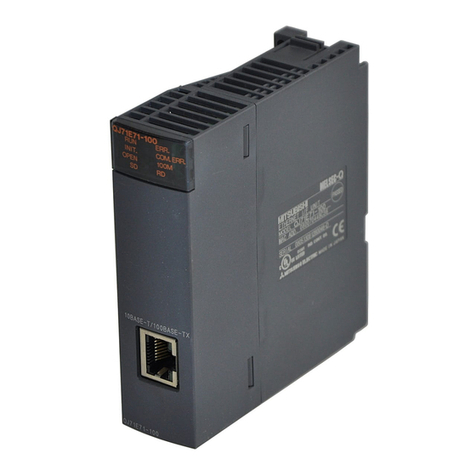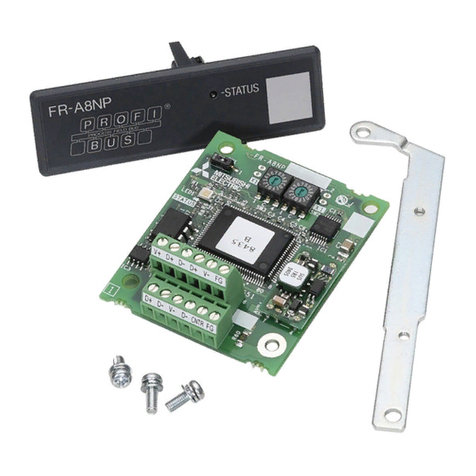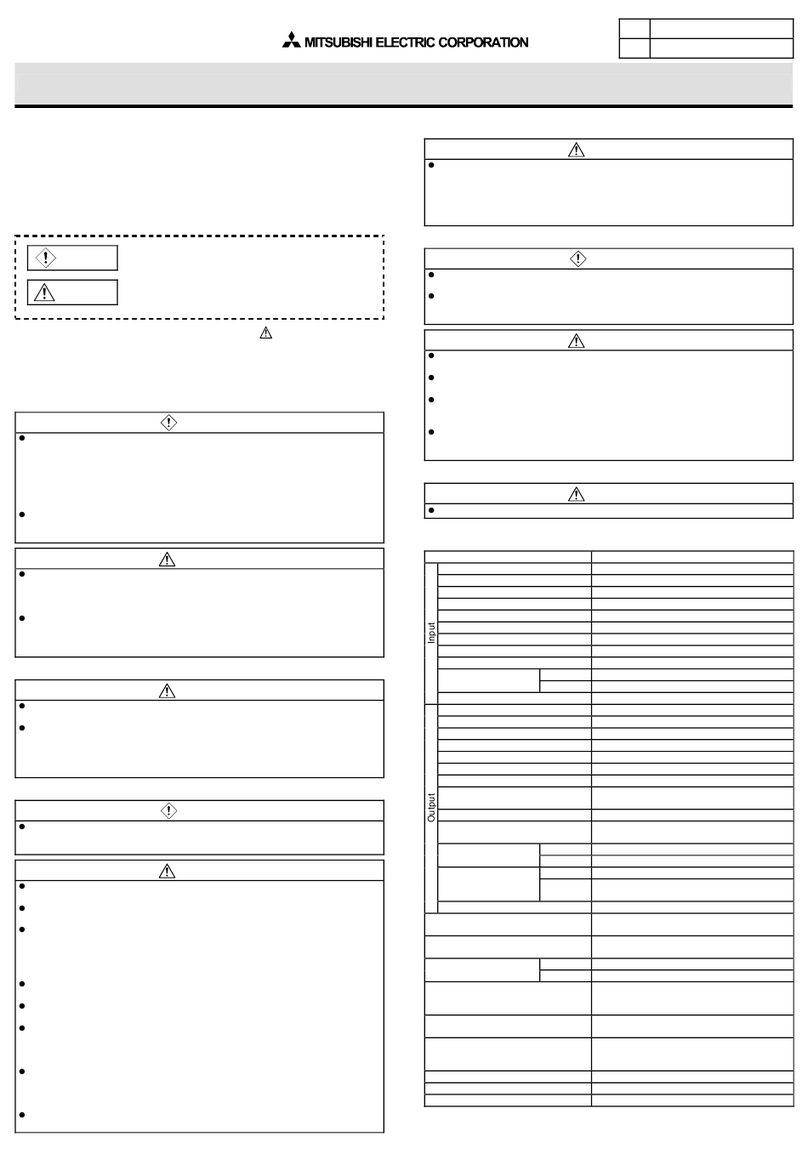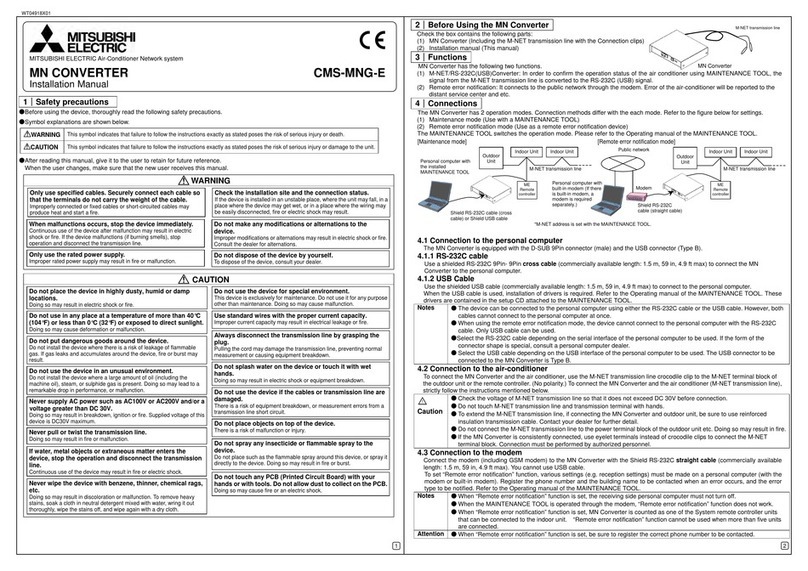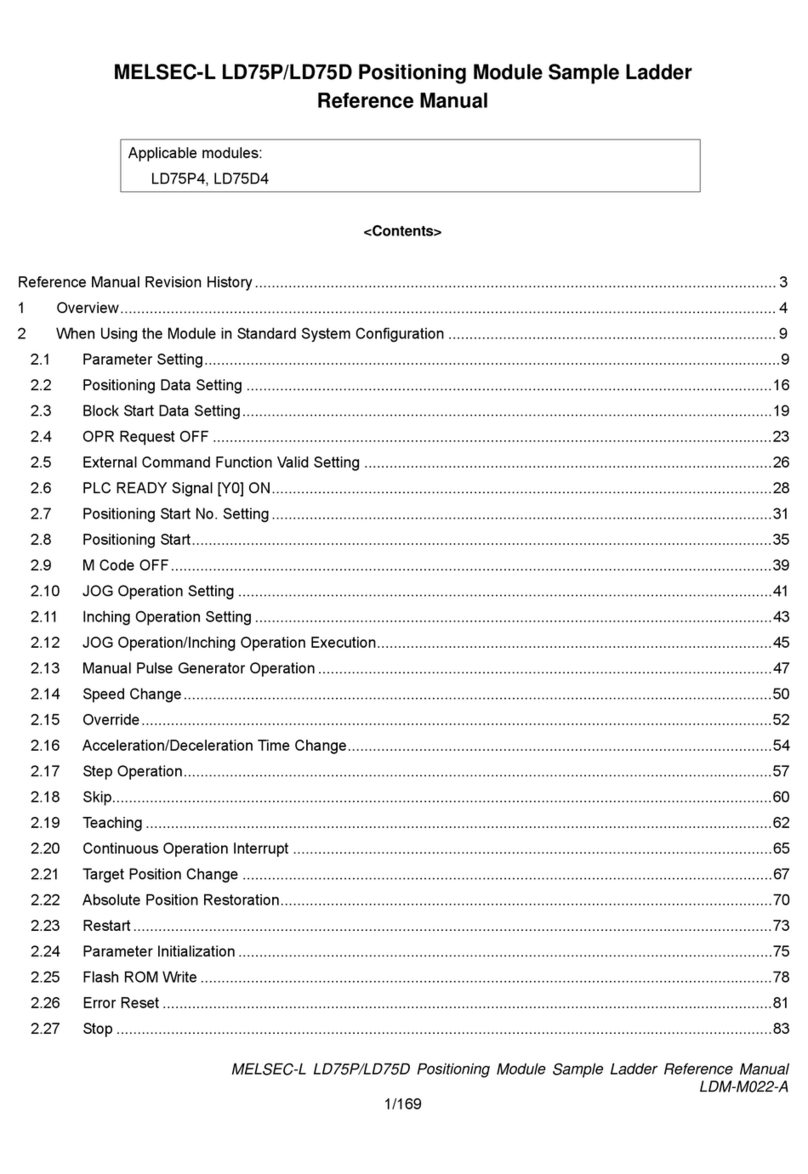
2.6 Connection to input/output terminal block
The input/output terminal blocks of the products which have -TS at the end of
their model name conform to spring clamp terminal block.
For details, refer to MELSEC iQ-F FX5UC User’s Manual (Hardware).
1) Wire size
2) Treatment of wire ends
When not using a ferrule, strip the cable about 10 mm from the tip and connect
it as a strand wire so that the wires do not separate.
When using a ferrule,
strip the cable about 10 mm from the tip to connect a wire ferrule at the
striped area.
Failure to do so may result in electric shock or short circuit
between adjacent terminals because the conductive part. If the wire strip length
is too short, it may result in the poor contact to the spring clamp terminal part.
When using a wire ferrule with an insulating sleeve, choose a wire with
proper cable sheath referring to the above outside dimensions, otherwise
the wire cannot be inserted easily.
The following table shows wire ferrules and tools for wire ferrules
compatible with the terminal block. Use of items other than these may
result in not being able to remove the wire ferrule, so carefully check that
the wire ferrule can be unplugged.
<Reference product>
3) Connection and disconnection of the cable
Spring clamp terminal block is the push-in type, therefore, wiring without a
tool is possible only by inserting the connecting terminal to the terminal
block. However, the stranded wire does not comply with the push-in type,
and a tool is required for connecting cables.
•Connection of the cable
Fully insert a cable or bar solderless terminal whose end has been
properly processed into the wire insertion opening.
If the cable or bar solderless terminal cannot be inserted with this
procedure, fully insert the cable or bar solderless terminal while pushing
the open/close button with a flathead screwdriver having a tip width of
2.0 to 2.5 mm. After fully inserting the cable, remove the screwdriver.
Do not tighten terminal screws exceeding the specified torque range.
Otherwise it may cause equipment failure or malfunction.
When wiring with the thick electric wire, make sure to prevent the
conductive parts from protruding to the front of the terminal block.
<Reference>
•Disconnection of the cable
While pushing the open/close button with a flathead screwdriver having a
tip width of 2.0 to 2.5 mm, disconnect the cable or bar solderless terminal.
2.7 Connection to built-in RS-485 Communication
terminal block
The built-in RS-485 Communication terminal block conform to terminal block
(European type).
For details, refer to MELSEC iQ-F FX5UC User’s Manual (Hardware).
1) Wire size
2) Treatment of wire ends
Strip the coating of strand wire and twist the cable core before connecting
it, or strip the coating of single wire before connecting it. An alternative
connection is to use a ferrule with insulating sleeve.
When using a wire ferrule with an insulating sleeve, choose a wire with
proper cable sheath referring to the above outside dimensions, otherwise
the wire cannot be inserted easily.
Tighten the screws to a torque of 0.22 to 0.25 N⋅m.
Do not tighten terminal screws with a torque outside the above-mentioned
range.
Failure to do so may cause equipment failures or malfunctions.
3) Tool
For tightening the terminal, use a
commercially available small
screwdriver having a straight form
that is not widened toward the end
as shown right.
Note:
If the diameter of screwdriver grip
is too small, tightening torque may
not be achieved. To achieve the appropriate tightening torque shown in the
table above, use the following screwdriver or appropriate replacement (grip
diameter: approximately 25 mm).
3. Specifications and examples of external wiring
As for the details of the power supply wiring and input/output wiring, refer to
MELSEC iQ-F FX5UC User's Manual (Hardware)..
No. of wire
per terminal
Wire size
Single wire/Strand
wire
Ferrules with
insulation sleeve
Ferrules without
insulation sleeve
One wire AWG24 to 16 AWG23 to 19 AWG23 to 16
Manufacturer Model Wire size Crimp tool
PHOENIX CONTACT
GmbH & Co. KG
AI 0.5-10 WH 0.5 mm2
CRIMPFOX 6
AI 0.75-10 GY 0.75 mm2
A 1.0-10 1.0 mm2
A 1.5-10 1.5 mm2
Manufacturer Model
PHOENIX CONTACT GmbH & Co. KG SZS 0.4×2.5 VDE
No. of wire
per terminal
Wire size
Solid wire/Stranded
wire
Ferrules with insulating
sleeve
1 AWG22 to 20 AWG22 to 20
2AWG22
10 mm
Contact area
(Crimp area)
16 to 18 mm
2 to 2.8 mm
Insulation sleeve
- Ferrule with insulation sleeve
10 mm
- Strand wire/single wire
Manufacturer Model Caulking tool
PHOENIX CONTACT GmbH & Co. KG AI 0.5-6WH CRIMPFOX 6
Manufacturer Model names
PHOENIX CONTACT GmbH & Co. KG SZS 0.4 × 2.5
DESIGN PRECAUTIONS
•Make sure to set up the following safety circuits outside the PLC to ensure
safe system operation even during external power supply problems or
PLC failure. Otherwise, malfunctions may cause serious accidents.
- Most importantly, set up the following: an emergency stop circuit, a
protection circuit, an interlock circuit for opposite movements (such as
normal vs. reverse rotation), and an interlock circuit (to prevent
damage to the equipment at the upper and lower positioning limits).
- Note that when the CPU module detects an error, such as a watchdog
timer error, during self-diagnosis, all outputs are turned off. Also, when
an error that cannot be detected by the CPU module occurs in an input/
output control block, output control may be disabled.
External circuits and mechanisms should be designed to ensure safe
machinery operation in such a case.
- Note that when an error occurs in a relay, transistor or triac of an output
circuit, the output might stay on or off. For output signals that may lead
to serious accidents, external circuits and mechanisms should be
designed to ensure safe machinery operation in such a case.
•Construct an interlock circuit in the program so that the whole system
always operates on the safe side before executing the control (for data
change) of the PLC in operation. Read the manual thoroughly and ensure
complete safety before executing other controls (for program change,
parameter change, forcible output and operation status change) of the
PLC in operation. Otherwise, the machine may be damaged and
accidents may occur due to erroneous operations.
WIRING PRECAUTIONS
•Make sure to cut off all phases of the power supply externally before
attempting installation or wiring work.
Failure to do so may cause electric shock or damage to the product.
•Make sure to attach the terminal cover, provided as an accessory, before
turning on the power or initiating operation after installation or wiring work.
Failure to do so may cause electric shock.
•The rating temperature of the cable should be 80or more.
9 mm
- Strand wire/single wire
8 mm
14 mm
2.6 mm
Insulating sleeve Contact area
(Crimp area)
- Ferrule with insulation sleeve
0.4 mm 2.5 mm
With
straight tip
3.1 Power supply specifications and external wiring
3.1.1 Power supply specifications [CPU module]
*1 This item shows value when only the CPU module is used.
The value in [ ] is the value in the maximum configuration connectable to
the CPU module. (The value does not include the external 24 V DC
power supply of extension devices)
3.1.2 Example of external wiring
24 V DC power is supplied to the CPU module. CPU module supplies power
through dedicated power connector.
For the details, refer to the MELSEC iQ-F FX5UC User's Manual (Hardware).
*1 Class D grounding
See section 3.3 for details.
3.2 Grounding
Ground the PLC as stated below.
•Perform class D grounding. (Grounding resistance: 100 Ωor less)
•Ground the PLC independently if possible.
If it cannot be grounded independently, ground it jointly as shown below.
•Bring the grounding point close to the PLC as much as possible so that the
ground cable can be shortened.
3.3 Input specifications and external wiring
3.3.1 Input specifications [24 V DC input type]
WIRING PRECAUTIONS
•Please separate the AC power supply from the AC commercial power
supply network with an insulation transformer when connecting to AC
input module or AC output module.
•Make sure to properly wire to the terminal block (European type) in
accordance with the following precautions.
Failure to do so may cause electric shock, equipment failures, a short-
circuit, wire breakage, malfunctions, or damage to the product.
- The disposal size of the cable end should follow the dimensions
described in the manual.
- Tightening torque should follow the specifications in the manual.
- Twist the ends of stranded wires and make sure that there are no loose wires.
- Do not solder-plate the electric wire ends.
- Do not connect more than the specified number of wires or electric
wires of unspecified size.
- Affix the electric wires so that neither the terminal block nor the
connected parts are directly stressed.
•Make sure to properly wire to the spring clamp terminal block in
accordance with the following precautions.
Failure to do so may cause electric shock, equipment failures, a short-
circuit, wire breakage, malfunctions, or damage to the product.
- The disposal size of the cable end should follow the dimensions
described in the manual.
- Twist the ends of stranded wires and make sure that there are no loose wires.
- Do not solder-plate the electric wire ends.
- Do not connect more than the specified number of wires or electric
wires of unspecified size.
- Affix the electric wires so that neither the terminal block nor the
connected parts are directly stressed.
WIRING PRECAUTIONS
•
Perform class D grounding (grounding resistance: 100
Ω
or less) of the grounding
terminal on the CPU module and extension modules with a wire 2 mm
2
or thicker.
Do not use common grounding with heavy electrical systems (refer to
section 3.3).
•When drilling screw holes or wiring, make sure that cutting or wiring debris
do not enter the ventilation slits of the PLC.
Failure to do so may cause fire, equipment failures or malfunctions.
•Connect the power supply wiring to the dedicated terminals described in
this manual. If an AC power supply is connected to a DC input/output
terminal or DC power supply terminal, the PLC will burn out.
•
Do not wire vacant terminals externally. Doing so may damage the product.
•Make sure to observe the following precautions in order to prevent any
damage to the machinery or accidents due to malfunction of the PLC
caused by abnormal data written to the PLC due to the effects of noise.
- Do not bundle the power line, control line and communication cables
together with or lay them close to the main circuit, high-voltage line,
load line or power line. As a guideline, lay the power line, control line
and communication cables at least 100 mm away from the main circuit,
high-voltage line, load line or power line.
- Ground the shield of the shielded wire or shielded cable at one point on
the PLC. However, do not use common grounding with heavy electrical
systems.
Item Specification
Power supply voltage 24 V DC
Voltage fluctuation range +20%, -15%
Allowable instantaneous
power failure time
Operation can be continued upon occurrence
of instantaneous power failure for 5 ms or less.
Power fuse 125 V 3.15 A Time-lag Fuse
Rush
current
FX5UC-32M/35 A max. 0.5 ms or less/24 V DC
FX5UC-64MT/
FX5UC-96MT/40 A max. 0.5 ms or less/24 V DC
Power
consumption
*1
FX5UC-32M/5 W/24 V DC [30 W/24 V DC +20%, -15%]
FX5UC-64MT/8 W/24 V DC [33 W/24 V DC +20%, -15%]
FX5UC-96MT/11 W/24 V DC [36 W/24 V DC +20%, -15%]
24 V DC built-in power supply
capacity 500 mA
5 V DC built-in power supply
capacity 720 mA
Item Specification
Input signal voltage 24 V DC +20%, -15%
Input
impedance
CPU
module
X0 to X17 4.3 kΩ
X20 and
subsequent 5.6 kΩ
I/O module 5.6 kΩ
Input
signal
current
CPU
module
X0 to X17 5.3 mA/24 V DC
X20 and
subsequent 4.0 mA/24 V DC
I/O module 4.0 mA/24 V DC
ON input
sensitivity
current
CPU
module
X0 to X17 3.5 mA or more
X20 and
subsequent 3.0 mA or more
I/O module 3.0 mA or more
OFF input sensitivity current 1.5 mA or less
Input response time Refer to MELSEC iQ-F FX5UC
User's Manual (Hardware)
Input
signal
form
(Input
sensor
form)
FX5UC-MT/D
FX5-CEX/D
FX5-C32ET/D
•No-voltage contact input
•NPN open collector transistor
FX5UC-MT/DSS
FX5UC-32M/-TS
FX5-CEX/DS
FX5-C32EX/DS-TS
FX5-C32ET/DSS
FX5-C32ET/DS(S)-TS
•Sink input:
- No-voltage contact input
- NPN open collector transistor
•Source input:
- No-voltage contact input
- PNP open collector transistor
Input operation display LED on panel turns on when input.
(DISP switch IN side.)
24 V DC
Breaker,
Circuit protector,
Fuse etc. Power
on
Emergency
stop
Power supply for loads connected to CPU module output terminals
MC
PL
CPU module
Fuse
*1
PLC Other
equipment PLC Other
equipment PLC Other
equipment
Shared grounding
(Good condition)
Common grounding
(Not allowed)
Independent grounding
(Best condition)

